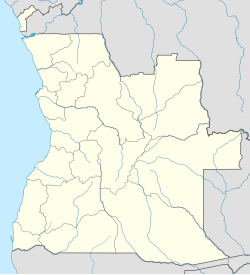Quilamba
Quilamba | |
|---|---|
Neighborhood | |
| Coordinates: 9°00′S 13°16′E / 9.000°S 13.267°E | |
| Country | Angola |
| Province | Luanda |
| Municipality | Belas |
| Founded by | China International Trust and Investment Corporation |
| Area | |
| • Total | 30.5 km2 (11.8 sq mi) |
| Time zone | UTC+1:00 (WAT) |
Quilamba (or Kilamba) is an Angolan neighborhood that serves as the administrative center of Belas Municipality and a large housing development site 30 km (18 miles) from Luanda, the capital city of Angola. It is being built by the China International Trust and Investment Corporation.
Quilamba covers an area of 30.5 square kilometers and will eventually offer homes for more than 200,000 inhabitants. It comprises about 750 apartment blocks ranging from 5 to 13 floors, over 100 commercial premises, 17 schools and 24 daycare centers to provide care and education for children, as well as over 240 stores to drive the local economy. The cost is reported at US$3.5 billion, financed by a Chinese credit line and repaid by the Angolan government with oil.
History[edit]
After the conclusion of Angola's civil war in 2002, the government began developing housing projects and satellite towns to meet the housing demands of a population which had largely lived in informal settlements.[1]: 125
Quilamba contributed to meeting the election pledge made by President Jose Eduardo dos Santos in 2008 to build a million new homes in four years. Development of Quilamba began in 2008.[1]: 125 As part of an exchange of Chinese construction materials and expertise for Angolan natural resources, CITIC Group Corporation Ltd. (a Chinese state-owned enterprise) led the development of Quilamba.[1]: 125
The government planned to use some of the residential blocks as social housing. As of July 2012[update], the buildings were largely complete but still unoccupied.[2] Despite a slow start, legislation signed into law by dos Santos resulted in a massive boom in demand.[3][4] Prices of the smallest units were reduced from US$125,000 to $70,000. The population increased to 40,000 residents in September 2013,[5] to 80,000 in July 2015.[6] In 2019, the estimated population was 129,000 inhabitants.[7] As of at least 2024, Quilamba has become a destination for aspiring middle class Angolans.[1]: 126
References[edit]
- ^ a b c d Curtis, Simon; Klaus, Ian (2024). The Belt and Road City: Geopolitics, Urbanization, and China's Search for a New International Order. New Haven and London: Yale University Press. doi:10.2307/jj.11589102. ISBN 9780300266900. JSTOR jj.11589102.
- ^ Louise Redvers (2 July 2012). "Footage shows African 'ghost town'". BBC News. Retrieved 4 July 2012.
- ^ Sandle, Adam. "Kilamba: New Initiatives Create Massive Demand". CNN iReport. Retrieved 12 April 2013.
- ^ Hammer, Derek. "Kilamba, from 0 to 200,000 inhabitants in 3 years". Merinews. Archived from the original on 1 July 2012. Retrieved 12 April 2013.
- ^ "Kilamba City Flats Sold Out". ANGOP (Angencia Angola Press). 4 September 2013.
- ^ Buire, Chloé (2 September 2015). "Views of suburban Luanda: banishing the ghosts from Kilamba". Africa Research Institute. Retrieved 26 November 2015.
- ^ Buire, Chloé (21 September 2021). "Kilamba tem 10 mil devedores". embaixada de Angola. Retrieved 22 September 2021.
External links[edit]
- Slideshow at Business Insider

